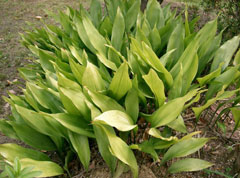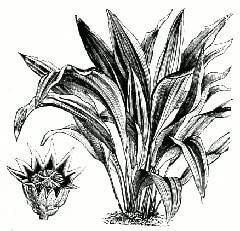 |
|
http://commons.wikimedia.org/wiki/User:KENPEI |
 |
| http://commons.wikimedia.org/wiki/File:Aspidistra_elatior.png |
Translate this page:
Summary
Bloom Color: Brown, Purple.
Main Bloom Time: Early spring, Late winter. Form: Rounded.
Physical Characteristics

 Aspidistra elatior is an evergreen Perennial growing to 0.6 m (2ft) by 0.5 m (1ft 8in) at a slow rate.
Aspidistra elatior is an evergreen Perennial growing to 0.6 m (2ft) by 0.5 m (1ft 8in) at a slow rate.
See above for USDA hardiness. It is hardy to UK zone 7. It is in leaf all year, in flower from January to April. The species is hermaphrodite (has both male and female organs) and is pollinated by Slugs, snails.
Suitable for: light (sandy), medium (loamy) and heavy (clay) soils, prefers well-drained soil and can grow in nutritionally poor soil. Suitable pH: mildly acid, neutral and basic (mildly alkaline) soils. It can grow in full shade (deep woodland) or semi-shade (light woodland). It prefers dry or moist soil and can tolerate drought.
UK Hardiness Map
US Hardiness Map
Synonyms
A. lurida. A. punctata.
Plant Habitats
Woodland Garden Dappled Shade; Shady Edge; Ground Cover;
Edible Uses
References More on Edible Uses
Medicinal Uses
Plants For A Future can not take any responsibility for any adverse effects from the use of plants. Always seek advice from a professional before using a plant medicinally.
Febrifuge Styptic Tonic Urinary
The roots, stems and leaves are febrifuge, styptic and tonic. Strengthens bones and muscles[147]. A decoction of the root, stems or leaves is used in the treatment of abdominal cramps, amenorrhoea, diarrhoea, myalgia, traumatic injuries and urinary stones[147, 218].
References More on Medicinal Uses
The Bookshop: Edible Plant Books
Our Latest books on Perennial Plants For Food Forests and Permaculture Gardens in paperback or digital formats.

Edible Tropical Plants
Food Forest Plants for Hotter Conditions: 250+ Plants For Tropical Food Forests & Permaculture Gardens.
More

Edible Temperate Plants
Plants for Your Food Forest: 500 Plants for Temperate Food Forests & Permaculture Gardens.
More

More Books
PFAF have eight books available in paperback and digital formats. Browse the shop for more information.
Shop Now
Other Uses
Aspidistras can be grown as a ground cover in a shady position[188].
Special Uses
Ground cover
References More on Other Uses
Cultivation details
Landscape Uses:Border, Container, Foundation, Ground cover, Massing, Specimen, Woodland garden. Prefers a shady position in a rich well-drained soil[200]. Tolerates poor soils and drought[200]. Almost hardy in Britain[1], plants can withstand temperatures down to about -15°c if they are well sited[200]. A plant growing under shrubs in Worcestershire has survived in the garden for over 30 years[233]. This plant used to be commonly grown as a house plant, it tolerates considerable neglect[200]. Special Features:Attractive foliage, Not North American native, Inconspicuous flowers or blooms.
References Carbon Farming Information and Carbon Sequestration Information
Temperature Converter
Type a value in the Celsius field to convert the value to Fahrenheit:
Fahrenheit:
The PFAF Bookshop
Plants For A Future have a number of books available in paperback and digital form. Book titles include Edible Plants, Edible Perennials, Edible Trees,Edible Shrubs, Woodland Gardening, and Temperate Food Forest Plants. Our new book is Food Forest Plants For Hotter Conditions (Tropical and Sub-Tropical).
Shop Now
Plant Propagation
Seed - sow spring in a greenhouse. When they are large enough to handle, prick the seedlings out into individual pots and grow them on for at least their first winter in the greenhouse. Plant them out in late spring or early summer after the last expected frosts. Division as the plant comes into growth in the spring[200]. Suckers. Best removed in the autumn and grown on in the greenhouse for the first winter.
Other Names
If available other names are mentioned here
Native Range
TEMPERATE ASIA: China
Weed Potential
Right plant wrong place. We are currently updating this section.
Please note that a plant may be invasive in one area but may not in your area so it's worth checking.
Conservation Status
IUCN Red List of Threatened Plants Status :

Growth: S = slow M = medium F = fast. Soil: L = light (sandy) M = medium H = heavy (clay). pH: A = acid N = neutral B = basic (alkaline). Shade: F = full shade S = semi-shade N = no shade. Moisture: D = dry M = Moist We = wet Wa = water.
Now available:
Food Forest Plants for Mediterranean Conditions
350+ Perennial Plants For Mediterranean and Drier Food Forests and Permaculture Gardens.
[Paperback and eBook]
This is the third in Plants For A Future's series of plant guides for food forests tailored to
specific climate zones. Following volumes on temperate and tropical ecosystems, this book focuses
on species suited to Mediterranean conditions—regions with hot, dry summers and cool, wet winters,
often facing the added challenge of climate change.
Read More
Expert comment
Author
Blume.
Botanical References
58200266
Links / References
For a list of references used on this page please go here
Readers comment